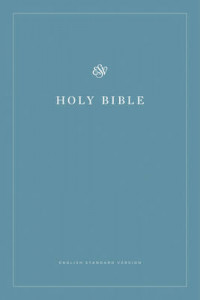What is the English Standard Version (ESV) Bible?
Aaron Lewendon - Eden Bibles & Bible Study Specialist
Finding the right Bible isn’t easy. There are dozens of translations and hundreds of editions to choose from. Our new series of guides is here to answer your questions about the different Bibles on offer today.

“Essentially literal” is the defining phrase of the English Standard Version (ESV) translation of the Bible. The ESV steers itself as closely as possible to original manuscripts making it a Bible of choice for many students, scholars, teachers and preachers. First published in 2001 by the American Christian publisher Crossway, the ESV Bible is itself an update of the Revised Standard Version of the Bible.
Offering remarkable depth and literary complexity, the ESV Bible is an illuminating translation for personal study as well as public reading.
History of the ESV
Every Bible translation arises out of a need. For the ESV Bible, that need was for a more literal Bible translation. A version for leaders and scholars that aligned with the language and understanding of today. But, before the ESV, and providing the foundation for its very creation, there was the Revised Standard Version (RSV) of the Bible.
First published in 1952, the RSV was designed as a literally accurate Bible in modern English. It also had the goal of carrying over the famous sense of literary excellence that is often associated with the King James Bible. This new update to the RSV was to be the next step in a long line of translations embracing accuracy and beauty.

Before work could begin on the ESV Bible, two things had to happen. First, the publisher needed to form a committee of scholars and overseers who reflect the beliefs and philosophies of this new Bible. Then they would need permission from the National Council of Churches in America to use the 1971 RSV as the basis for the ESV. Up to that point, the RSV was the accepted Bible for the scholarly establishment of the time. Without permission to use the RSV Bible, this project would be doomed before it even began. Fortunately, permission was granted. Crossway was ready to put their over 100-strong committee to work.
The resulting Bible was christened the English Standard Version, and in all about six per cent of the RSV was revised in the making of the ESV.
How Was It Translated?
When one Bible uses another as its textual basis, the first and arguably most pertinent question to be asked is how ‘much was changed?’. Even six per cent of a Bible amounts to dozens of pages worth of changes made. Some of these changes include:
Gender changes:
The ESV Bible uses a more gender-inclusive vocabulary in its translation where the context warrants its use and it still maintains fidelity to the original Greek or Hebrew. Words in those ancient languages often can mean either a specific gender or mixed groups of people. For example, words like ‘people’ and ‘man’ can both function as translations for the Greek word anthropoi (which is where we get words like Anthropology and Anthropocene). The ESV would sit on the side of not immediately using masculine language. Only using it when the masculine intention is clear. The Bible is for all people, but shouldn’t sacrifice fidelity in maintaining its relevance.
Denominational leaning:
Where the previous RSV Bible was used by both Protestants and Catholics alike at the time, the team brought together for the ESV featured a prominent number of Protestant scholars and translators. This included many Calvinists, Lutherans, Baptists and Wesleyans. In the process, many of the RSV’s passages that had been under debate and dispute for conservative Christians at the time were textually-modified in ways that align with Protestant beliefs.
How Accurate is the ESV Bible?
As mentioned, the ESV is described as being "essentially literal", but how far from literal is that?
Before answering, it helps to know two key terms used when discussing how accurate a Bible is. Whenever someone discusses Bible Translation accuracy, they will most likely draw a line in the sand between Bibles which are “word-for-word” and Bibles which are “thought-for-thought”.
Word-for-word Bibles present as directly as possible the text in the original scriptures. As the scriptures come from a culture far removed from our own, their texts are harder to understand and so any direct translations themselves require of the reader a sharp eye and working knowledge of the context from which the Bible came.
Thought-for-thought Bibles operate under a different approach. They employ a greater level of textual interpretation throughout their translation process. This includes taking in wider contexts and meanings as a guide to what the original text meant and how that text would appear in today’s language.
If word-for-word is akin to Google Translate, operating with as little human interpretation as possible, then thought-for-thought is like a poem translated from another language, where meaning and form carry greater emphasis.
But where does the ESV Bible sit on the spectrum?
As stated, the ESV hews as close to word-for-word as possible without losing the readability of the intent of the original text. Because there is a great difference between the grammar, syntax and even the more idiomatic and local quirks of ancient writing, some updating is necessary for creating a modern English translation. This necessity creates tension for translators. Where the ESV settles is in always maintaining literary excellence and clarity whilst drawing as close as possible to the original words. It's Essentially Literal.

How Easy is the ESV to Read?
The ESV Bible is written at a 10th Grade Reading Level. This means readers from the ages of 15 and up should be able to confidently read the majority of the ESV text and roughly understand what it means.
What determines this level is the total number of unique words and sentences, as well as sentence length and the length of the words themselves. Other grammatical features also carry weight in the score. The reading level doesn’t take into account any understanding of history and context. Just the words and grammar of the text.
As an example, this sentence you are currently reading would score at a Grade Nine on the readability test.
This sentence would be at Grade Two.
Common Uses
First and foremost, the ESV has been embraced by Christian scholars and theologians. That doesn’t mean that it's cordoned off to the wider Christian readership. Not by a long stretch. Its written richness has lifted the ESV up to the position of being a well-loved Bible for many in the English speaking world. It has even become the translation of choice for many UK Churches. This in part due to an Anglicised edition of the ESV Bible published by HarperCollins.
Different Editions
As mentioned, the ESV Bible itself is a revision of the RSV Bible (which was, in turn, a revision of the American Standard Version Bible from 1901). Since it’s release, though, it has undergone three notable revisions since its release in 2001.
The first one was in 2007, and it was only a minor revision. All in all, it changed about 500 words to better improve the clarity of meaning, and for a greater grammatical consistency. The same again for the 2011 revision, which built upon the changes made four years prior and was done to similar effect.
In 2016, four years after the last revision, Crossway made one more update that changed 52 words in the text. They titled this revision the "ESV Permanent Text Edition". Since then, minimal changes to the text have been made, but not as a formalised revision. Just minor tweaks.
Example verses from the ESV Bible
For God so loved the world, that he gave his only Son, that whoever believes in him should not perish but have eternal life. - John 3:16
For I know the plans I have for you, declares the Lord, plans for welfare and not for evil, to give you a future and a hope. - Jeremiah 29:11
Be kind to one another, tenderhearted, forgiving one another, as God in Christ forgave you. - Ephesians 4:32
Versions You Can Buy
Wherever Bibles are sold, you will now most likely be buying the 2016 edition of the ESV Bible. That doesn’t mean you don’t have a choice in which ESV is right for you. Some of the most popular ESV Bibles people buy and read and love include:
As the ESV Bible was commissioned with deeper reading in mind, it comes as no surprise a study edition is one of the most popular choices available. The ESV Study Bible prides itself on its comprehensiveness. Featuring thousands of study notes throughout the text, this edition is designed to help you understand the text in a new, deeper way.
One thing the ESV is known for is its elegance. Its finesse and beauty. Reflecting those qualities, the ESV Illuminated Bible is a journalling edition that features beautiful images and artwork throughout. All inspired by the ESV text. It also uses thick paper and wide margins to aid your personal notes, drawings, and reflections.
ESV Archaeology Study Bible
The phrase ‘digging into the Bible’ is used a lot, but with the ESV Archaeology Study Bible that phrase takes on a new pertinence. With a focus on the historical and cultural contexts of the Bible, the Archeology Bible is a ground-level look at the world of the Bible. It draws on a range of photographs, diagrams, studies, articles and archaeological discoveries to build up a richer picture of the events and meanings in the Bible.

An affordable paperback edition of the complete ESV Bible, this Economy version is the ideal choice for outreach or to try the text for yourself. It includes a 40-day reading plan, introductions to the two testaments and a “Why Read the Bible?” article for newer Christians.
Frequently Asked Questions
Every day, people turn to the Bible for questions about faith, life, meaning, Christianity and countless other topics. But as well as having questions for the Bible, there are also many questions asked about the Bible. Here we’ll try to answer some of those most asked questions.
Is the ESV Bible Catholic?
Whilst not initially intended for a Catholic readership, in subsequent years the Deuterocanonical books have been added to some editions of the ESV bible, and in 2018 Conference of Catholic Bishops of India released the Catholic Edition of the ESV Bible.
How many words are in the ESV Bible?
According to wordcounter.io, there are 757439 words in the ESV Bible.
Does the ESV Bible have the Apocrypha?
For some editions, yes. Oxford University Press published an edition of the ESV Bible that features the deuterocanonical books. These ESV Apocryphal books were, as with the rest of the ESV Bible, textually-based on the RSV Bible.
Is the ESV Gender Neutral?
The ESV uses a greater amount of gender-neutral language than its predecessor, the RSV Bible. The ESV only employs gender-neutral language when a wider gender term more is fitting with the original scriptures and texts.
Other Bible Translations:
Click on any of the images below to learn all about the stories behind some of the world's most widely-read Bible translations.






.jpg)
Latest Blogs

Bible
30+ Powerful Quotes About the Bible (For Inspiration in 2026)
Looking for inspiration? Discover a curated collection of the most powerful quotes about the Bible, from famous historical figures to modern theologians and Scripture itself.

Bibles
What is the "Standard" Bible for Christians?
Is there an "official" Bible that all Christians use? We explain the difference between the NIV, KJV, and ESV, and help you find the standard text for your church or personal reading.

Bible
"I Keep Failing to Read the Bible" – 5 Tips to Make the Habit Stick
Do you start a Bible reading plan only to quit a few weeks later? Stop the cycle of guilt. Here are 5 psychological tips and practical changes to help you build a Bible habit that actually lasts in 2026.

Bible
Where to Start Reading the Bible (5 Great Books for Beginners)
Confused about where to start reading the Bible? Don't start at page one! Here are the 5 best books for beginners to start with, from the action of Mark to the wisdom of Proverbs.

Bible
How to Start Reading the Bible for the First Time
Feeling overwhelmed by the Bible? You are not alone. Here is a simple, jargon-free guide on where to start, which translation to choose, and how to make sense of it all.

Bible
How to Read the Bible in a Year (A Simple 15-Minute Daily Plan)
A practical breakdown showing that reading the entire Bible in a year requires only 15 minutes a day, with tips on how to fit this simple habit into your daily routine.
